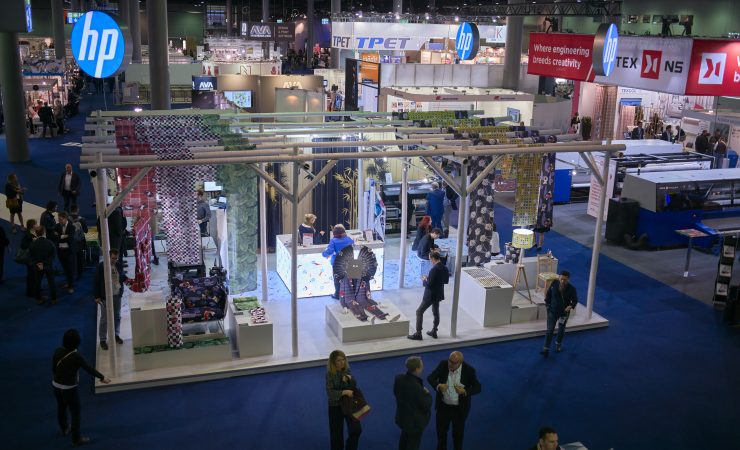We visited Heimtextil, which claims to be the world’s biggest trade show, on its 50th anniversary to see how digital print is progressing in the home décor market.
Heimtextil covers trends in the interior design market and mainly appeals to designers. In previous years it’s attracted a number of digital print vendors, who see huge potential in the market for printing home textiles such as upholstery, curtains and bed linen. There was only a handful of digital printers this year, though several vendors mentioned that it was difficult to commit to other shows in a drupa year.
Mtex managed to cram two textile printers, the Falcon and the Eagle, onto its stand, both of which are 3.2m wide. The company launched the Falcon at last year’s ITMA show with four colours and 16 printheads, but for Heimtextil this was upgraded to a newer 8-colour version with 32 printheads. It uses Konica Minolta printheads, with 720dpi resolution and is able to run at up to 152sqm/hr. It prints CMYK plus green, blue, orange and grey, using a pigment ink that’s suitable for cotton, polycotton and polyester.
The Falcon is designed to compete directly against other scanning printers from MS and EFI Reggiani but does away with the sticky belt to help keep the cost down. This does mean it can’t handle stretchable fabrics but as André Jacques, vice president of sales and marketing for Mtex, says, ‘The set-up is much faster and we don’t need the glue.’
The Mtex Eagle is a dye sublimation printer that has 16 printheads and uses CMYK disperse inks to print polyester materials. It comes complete with a built-in heated chamber rather than using IR lamps and can be used both for home décor applications as well as display graphics such as banners, flags and back-lits.
The JK Group was keen to showcase how the different companies in the group work together. Thus there was a JP4 Evo from MS, which is a 3.2m wide scanning printer. This was loaded with Digistar Bellagio, a reactive ink developed by Kiian Digital that was launched last year and is suitable for printing to cotton and other cellulose-based fibres. This ink is available as a third-party option for other printers but for now will only work with machines that use Kyocera printheads since it was designed around the MS machines which use them; the intention is to extend these reactive inks to other printheads as well.
HP showed off both a latex and a dye-sub printer. Business development manager for HP signage and decoration Jane Rixon says that each has a place in the home decor market, with latex being better for surfaces that you might want to wipe clean, while the Stitch dye-sub range launched last year is more suitable for things that need to be washed.
Off the wall
Xeikon estimates that it has roughly half the market for digitally-printed wallpapers, with HP Latex accounting for the other half. Sadly, Xeikon did not bring its wallpaper décor suite to Heimtextil, though it has been working with Felix Schoeller to develop new wallpapers for use in its dry toner presses. These include Vegas, a coated wallpaper available with a silver or gold metallic effect, and Oslo, an embossed coated wallpaper. These are self-adhesive conventional non-woven wallpapers, which is to say that they are made of PVC rather than paper.
This brings us to Olbrich’s partnership with Ricoh. Olbrich makes conventional production lines for non-woven wallpaper based around gravure printing. Ricoh has come on board to develop an inkjet module that can be added to an Olbrich production line, and the two have worked with wallpaper producer Marburg to ensure that this solution meets the requirements of the market.
The Ricoh unit is a single-pass inkjet module based on Ricoh’s Gen5 printheads that can run at up to 70m/min at 600dpi. It uses an oil-based ink that doesn’t evaporate in the atmosphere so there’s no danger of the ink clogging the heads. For now, it’s printing CMYK, though there is room for up to six print channels. Marburg has been running the Ricoh unit on its Olbrich production line since last May and was confident enough in the results to show off wallpapers at Heimtextil that had been printed on this system.
It’s obvious from the sheer size of Heimtextil, which occupies almost the whole of the Frankfurt Messe, that the interior décor market represents massive potential for digital printing. But it appears that, with the exception of dye sublimation to polyester, digital textile printing still has some way to go in terms of the types of substrates that it can handle before it can really take a sizeable chunk of this market. Some of the vendors explained that although they had the ability to print to upholstery, for example, the prints aren’t really hard wearing enough. But we are really still at the beginning of digital printing of textiles and it’s inevitable that we will see a lot of new, more hard-wearing inks over the next couple of years.
The real opportunity for digital is to change the approach to manufacturing to allow for a decentralised approach where customers place orders through a cloud-based system, and for the printing to take place locally to those customers. This plays to the strengths of digital print for short-run ono-demand production and removes the major environmental overhead of having to transport products over long distances from a central manufacturing point. It also offers an opportunity to ‘re-shore’ work that moved overseas decades ago.





